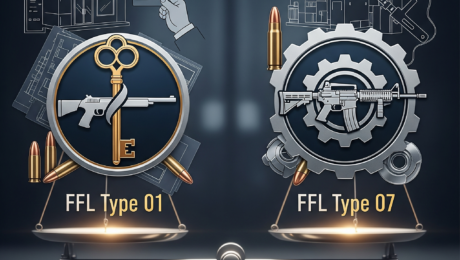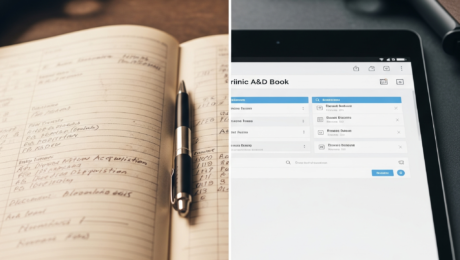Dreaming of turning your passion for firearms into a business? The first, and most critical, step is navigating the world of Federal Firearms Licenses, or FFLs. While there are many types of FFLs, two stand out as the most common choices for new entrepreneurs: the Type 01 and the Type 07. Understanding the key differences between them is not just about choosing a license; it’s about defining the entire scope and potential of your business. Let’s break down what each one offers and who it’s best suited for. The Type 01 FFL: The Dealer and Gunsmith The Type 01 FFL is the bedrock of the retail firearms industry. It’s the license held by most local gun shops and by many home-based dealers. As the most common FFL, it’s perfect for anyone whose primary business model revolves around buying and selling firearms from established manufacturers, as well as providing repair services. What You Can Do: Retail Sales: You are authorized to purchase and sell Title 1 firearms to the public. This is what you need for a standard retail storefront or a thriving online business handling transfers. Gunsmithing: You can perform repairs and customizations on firearms. This is a valuable service that can be a significant source of income. Important Limitations to Consider: The main limitation of the Type 01 FFL is manufacturing. You are not permitted to manufacture firearms for sale. This isn’t just about building guns from scratch; it also includes assembling a firearm from a receiver and parts kit. This is a crucial distinction. For example, building a custom AR-15 from a stripped lower receiver and a parts kit, and then selling it, is considered manufacturing and is strictly forbidden with a Type 01 license. Additionally, you cannot sell NFA items like suppressors, short-barreled rifles (SBRs), or machine guns without obtaining a separate Class 03 SOT, and even then, you can only deal in them, not make them. The Type 01 FFL has a $200 application fee and a $90 renewal fee every three years. It’s a great, cost-effective starting point for a simple and focused business model. The Type 07 FFL: The Manufacturer and Innovator If you have a bigger vision for your business, the Type 07 FFL is your ultimate tool. This license is a game-changer because it includes all the privileges of a Type 01 FFL and adds the crucial ability to manufacture firearms and ammunition. It opens the door to creating your own products and tapping into some of the most lucrative markets in the industry. What You Can Do: Everything a Type 01 Can: Buy, sell, and repair firearms. Manufacture: You can build firearms from the ground up, assemble guns from kits for resale, and produce your own line of firearms. This is why many people get this license—the ability to create custom AR-type rifles, a hugely popular market, is a significant advantage. The NFA Market: The real power of the Type 07 comes when you pair it with a Class 02 SOT. With this combination, you can legally manufacture and deal in all types of NFA items, including suppressors, SBRs, short-barreled shotguns, and even machine guns. With the rising demand for suppressors and other NFA items, this capability can be a massive revenue driver for your business. The Type 07 FFL costs $150 to apply and $150 to renew every three years. While the renewal is slightly higher than the Type 01, the expanded opportunities it provides often make this a small investment for a large return. Ultimately, the choice comes down to your long-term business goals. Do you want to be a local gun shop that serves your community with sales and repairs? The Type 01 is your best bet. Do you want to build a brand, create a custom line of rifles, or tap into the highly profitable NFA market? The Type 07 gives you the freedom and flexibility to do all that and more. Consider where you want your business to be in five years. Your FFL license is the foundation—make sure you build it on the right one.
As an FFL dealer or pawnshop owner, you are constantly looking for the next big business upgrade—a new security system, a better display case, or a faster internet connection. But what if the most impactful upgrade for your business isn’t a piece of hardware, but a digital solution that modernizes your entire operation? Your Acquisitions and Dispositions (A&D) book, the very foundation of your business, is ready for a revolutionary upgrade. By moving beyond the traditional paper log, you can transform a legal burden into a powerful tool for efficiency and profitability. Platforms like e4473.com and Bravo Store Systems offer this essential upgrade, integrating compliance directly into your daily workflow to make your entire business faster, smarter, and more secure. Upgrade Your Inventory Management Manually entering every item into a physical book is not just tedious—it’s a recipe for costly mistakes. A single misplaced digit can lead to a failed ATF audit. A digital A&D book is a fundamental upgrade that eliminates this risk. Item details – like serial number and manufacturer – are automatically pulled from the transaction record into the A&D log, eliminating redundant data entry. This saves you countless hours and ensures every record is flawless. With a system that links your A&D book to your Point of Sale (POS), your inventory is updated in real time. The moment an item is acquired or sold, its status is instantly updated in your digital log. This gives you an accurate, up-to-the-minute view of your stock without ever having to close your doors for a manual count. Upgrade Your Sales Process The moment of a firearm sale is where a digital A&D book truly shines. Instead of fumbling through a paper log, you can complete the Form 4473 electronically. E4473 specializes in this, guiding you through the form to ensure every required field is completed accurately. This is a critical upgrade that not only speeds up the checkout process but also drastically reduces the risk of errors that could lead to a failed audit. The digital log then automatically records the transaction details, linking the firearm to the buyer’s information. This seamless process eliminates redundancy and ensures a perfect, compliant record for every single sale. It’s an instant, stress-free path to compliance that leaves you free to focus on the customer. Upgrade Your Business Intelligence When your A&D book is a fully integrated part of your business software, every process becomes more efficient. Bravo Store Systems, for example, combines your digital A&D book with a robust POS, comprehensive inventory management, customer management, and in-depth reporting tools. This all-in-one approach means your entire business—from compliance to sales – is connected. With everything in one place, you can generate reports that provide crucial business insights. You can track which firearms are your best sellers, identify trends in your inventory, and manage your customer relationships with ease. A digital A&D book is more than a convenience; it’s a strategic asset that makes your operations faster, reduces compliance risk, and frees you up to focus on what matters most: growing your business and increasing your bottom line.
For every Federal Firearms Licensee (FFL), the Acquisition & Disposition (A&D) book, or “bound book,” is the bedrock of compliance. This meticulous record tracks every single firearm that enters and leaves your store. While the traditional paper bound book has been the standard for generations, the digital revolution has introduced a powerful alternative: the electronic A&D book. So, which method is the best fit for your business? Let’s dive deep into a robust comparison of both to help you make an informed decision. The Paper Bound Book: The Old-School Standard The paper A&D book is a familiar sight in gun shops across the country. It’s a physical ledger where every firearm transaction is meticulously logged by hand. Pros: Simplicity and Accessibility: The paper bound book is fundamentally low-tech. It doesn’t require an internet connection, software, or hardware. All you need is a pen and the book itself, making it a reliable backup even in the event of a total power outage or system failure. Physical Security: A physical book is a tangible asset. It’s stored on-site, providing a sense of control and security that some FFLs prefer. Cons: High Risk of Human Error: This is the single biggest drawback. Illegible handwriting, transposed serial numbers, missed entries, or incorrect dates are common and can lead to serious compliance issues. A single, seemingly minor error can invalidate an entire page, potentially leading to warnings, fines, or even license revocation during an ATF audit. Inefficiency and Time Consumption: Manually entering every single detail—manufacturer, model, serial number, caliber, and transaction date—is a slow, tedious, and labor-intensive process. This takes valuable staff time away from sales and customer engagement, directly impacting your bottom line. Vulnerability to Damage and Loss: A paper book is a fragile asset. It can be easily lost, stolen, or destroyed by natural disasters like fire or flood. Losing your bound book is one of the most severe compliance violations an FFL can face, with potentially business-ending consequences. Auditing and Retrieval Nightmares: When an ATF inspector arrives, a paper bound book audit can be an arduous process. Finding a specific transaction or running a report on a particular firearm requires flipping through hundreds or thousands of pages, a process that is both inefficient and stressful. The Electronic A&D Book: The Modern, Secure Solution Electronic A&D books use software to digitize and manage all firearm acquisitions and dispositions. This modern approach is rapidly becoming the industry standard for FFLs committed to efficiency and compliance. Pros: Unparalleled Accuracy and Error Prevention: A robust electronic system uses built-in validation checks to prevent common mistakes. It automatically flags incorrect serial numbers, missing information, or invalid dates, ensuring that your records are clean and audit-ready from the moment of entry. Massive Time Savings: With transaction-linked entry and inventory scanning support, acquiring or disposing of firearms becomes far faster and less error-prone. This frees up your staff to focus on what matters most: serving customers and driving sales. Enhanced Security and Redundancy: Your data is not at risk of physical damage. It’s stored securely in the cloud with automatic, regular backups. This protects your critical records from fire, flood, theft, and other physical threats. Access is password-protected, and the best systems offer advanced security features like two-factor authentication to prevent unauthorized access. Instantaneous Auditing and Reporting: An ATF audit is a breeze with an electronic A&D book. You can instantly generate reports, search for specific firearms by serial number or customer name, and provide auditors with a clean, verifiable record in a fraction of the time it would take with a paper book. Cons: Requires Technology: An electronic system relies on hardware, software, and a reliable internet connection. While most systems offer offline capabilities as a backup, it’s still a point of dependency. The Ultimate Answer: E4473.com + Bravo Store Systems While an electronic A&D book is a clear win, not all systems are created equal. The ultimate solution lies in a seamless, integrated platform that automates the entire process, minimizing risk and maximizing efficiency. This is where the powerful combination of E4473 and Bravo Store Systems sets the new industry standard. E4473 is a leading ATF-compliant platform that digitizes the entire Form 4473 process, ensuring accuracy and a streamlined customer experience. When a customer completes the digital Form 4473, the data is validated in real-time. The magic happens when you pair this with Bravo Store Systems, an industry-leading all-in-one POS and inventory management solution. Upon a sale or acquisition within Bravo, the information automatically and instantly populates your digital A&D book. This integration completely eliminates the need for manual data entry, removing the risk of human error and saving your staff countless hours. The result is a bound book that is always accurate, secure, and ready for an audit. By leveraging this powerful synergy, you’re not just switching from paper to digital—you’re implementing an end-to-end compliance and operational solution that protects your FFL and positions your business for future growth.
Becoming a Federal Firearms Licensee (FFL) as a pawn owner is a significant step that allows you to expand your business to include the sale and transfer of firearms. This transition requires careful planning and adherence to strict federal regulations. Here’s a guide to help you navigate the process and how modern software solutions can make it easier. Understand the Requirements Before you begin, familiarize yourself with the FFL requirements set by the Bureau of Alcohol, Tobacco, Firearms and Explosives (ATF). You must be a U.S. citizen or permanent resident, at least 21 years old, and have a business license. You also need to have a secure business location and a clean record, free from any disqualifying criminal convictions. Choose the Right License Type The most common FFL for pawn shops is a Type 01, which allows for dealing in and pawnbroking of firearms. You’ll need a Type 01 to expand your business to include firearm sales. Complete the Application The FFL application process involves filling out ATF Form 5310.12, also known as the Application for an FFL. You’ll need to provide detailed information about your business, including your business name, address, and contact information. You will also need to submit fingerprints and a photograph. Pass the Background Check and Inspection The ATF will conduct a thorough background check and an inspection of your business location to ensure you meet all the requirements and have the necessary security measures in place. This process can take several weeks or months. Stay in Compliance with Technology Once you have your FFL, the most challenging part is often maintaining compliance with a wide range of regulations. This is where specialized software like Bravo Store Systems and E4473 becomes invaluable. These solutions are designed to automate and simplify the compliance process, helping you avoid costly errors and violations. Digital Form 4473 (E4473): The ATF Form 4473 is a critical and complex document for every firearm transaction. Using a digital solution like e4473.com eliminates the need for paper forms. It provides built-in validation checks to prevent common mistakes, ensuring all required fields are filled out correctly and reducing the risk of a violation during an ATF audit. The system is meticulously designed to stay up-to-date with the latest ATF regulations, giving you peace of mind. Integrated Point-of-Sale and Compliance (Bravo Store Systems): Bravo Store Systems is a comprehensive point-of-sale (POS) and inventory management platform built specifically for pawn shops and firearms retailers. It integrates directly with E4473, creating a seamless workflow. When you make a firearm sale, the system automatically starts the E4473 process, populating information and guiding the transaction. This eliminates manual data entry and reduces the chances of human error. Automated Acquisition & Disposition (A&D) Book: The A&D book is your chronological log of every firearm that enters and leaves your inventory. A digital solution from Bravo Store Systems automates this process. When you process a sale through E4473, the system automatically updates your digital A&D book, ensuring your records are accurate, complete, and always audit-ready. Secure Digital Storage: Instead of storing thousands of paper forms, these platforms securely store all your digital records in the cloud. This makes retrieving forms for an ATF audit or a trace request quick and stress-free. It also adds a layer of security, protecting sensitive data from loss or theft. By leveraging these integrated software solutions, you can streamline your operations, reduce liability, and focus on growing your business with the confidence that you are staying in compliance with federal regulations.
The safest way to sell firearms
Schedule your FREE live demo today to see E4473 in action.
![]()





